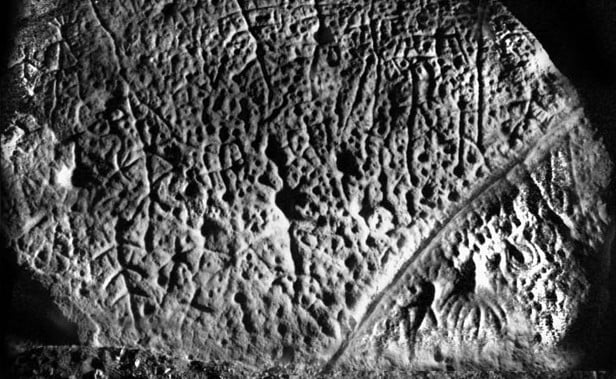While most rock art sites in the South are on private property, there are a few impressive etchings found on public lands.
Judacalla, N.C.
The petroglyphs are made on a soapstone boulder that includes hundreds of cupules and deep grooves, as well as a number of designs that resemble humans, footprints, and geometric shapes. The site has recently been rehabilitated by Jackson County Parks and Recreation and the U.S. Forest Service, and it now features a viewing platform and interpretive signs. A portion of the boulder that was previously hidden by dirt has also been excavated.
Track Rock, GA.
Six table-sized soapstone boulders containing more than a hundred rock carvings reside on national forest land near Blairsville. The site has recently been rehabilitated with a new viewing platform and interpretive signs. Animal tracks, crosses, footprints, and handprints are common. One human foot has six toes, and a couple of stick figures are upside down, which archaeologists believe refers to the spirit world. One of the Cherokee legends associated with Track Rock involves worldwide flooding survived by one family and a host of animals meant to repopulate the world. Their canoe landed at Track Rock and their troop of animals disembarked, leaving their impressions on the rock as they passed.
Paint Rock, N.C.
One of the few pictograph sites (painted, not etched) in the South, Paint Rock sits in Pisgah National Forest on a high bluff near Hot Springs. Images of humans, fish, and fowls were painted in red circa 2500 B.C. It’s the oldest pictograph in the Southeast. Today, the markings can be difficult to discern, and hikers often confuse natural iron markings with the original paintings.
Indian God Rock, PA.
The petroglyphs on Indian God Rock along the Allegheny River in western Pennsylvania were likely carved by the ancestors of the Shawnee between A.D. 900 and 1650. The petroglyphs can be difficult to see, but interpretive panels discuss the cultural and historical significance of the site and aid in locating specific markings, which include geometric designs and animals and humans in “x-ray” form.








